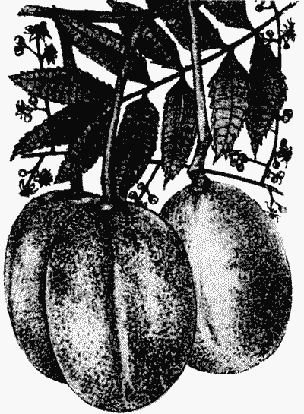
Hog Plum
Scientific
name: Spondias
cytherea
Family:
Anacardiacae

The genus Spondias
belongs to the Anacardiacae or Cashew family, which also includes the
mango.
It
has about 8 to 10 species in the genus found in the tropics of Asia and
America. The fruits of some of these species constitute an important
source of food in their native areas.
Spondias
cytherea (syn. S.
dulcis)
is commonly called the Ambarella or Otheite Apple. The species forms a
medium-sized tree 12-15 metres tall, with a smooth bark and large
pinnate leaves to 40cm long. The flowers are borne terminally in spring
and fruits ripen in the autumn and early winter.
The fruit is
6-8cm long and 5-6cm in diameter. The skin is yellow when ripe and
somewhat leathery. The edible flesh is yellow in colour and about 1 cm
thick. The stone, or seed casing, has spines that stick out into the
flesh and complicates the use of the fruit. Seeds are produced in 5
small cavities in the stone. Only 1 or 2 of the seeds will be
developed. There is some variation among seedlings, some being sweeter
and with a thicker flesh than others.
S. cytherea
can be grown from a seed or from cuttings. The Ambarella is the
hardiest of the spondias, taking a little bit more cold than the others.
They
require good drainage, but will grow in rich or poor soils. They have
to grow in full sunlight to produce fruit. A shaded tree will produce
little or no fruit. The trees are also drought tolerant. They will go
dormant in late winter.
The fruits usually drop off when they
turn yellow. I have found that they can be picked green and they will
turn yellow in about 5 days at room temperature. The taste is
reminiscent of pineapples. The fruit can be used in jams, jellies and
sauces when ripe, and when unripe, in pickles or relishes. A very tasty
jam can be made.
Back to
Ambarella Page
|

